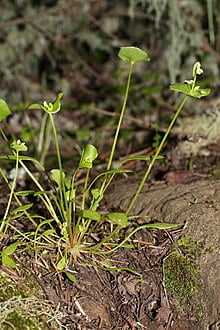Claytonia perfoliata

Claytonia perfoliata (syn. Montia perfoliata), also known as miner’s lettuce, Indian lettuce, spring beauty, winter purslane, or palsingat, is a flowering plant in the family Montiaceae. It is a fleshy, herbaceous, annual plant native to the western mountain and coastal regions of North America, from southernmost Alaska and central British Columbia, all the way south to Central America, but most common in California in the Sacramento and northern San Joaquin Valleys.
Together with Claytonia parviflora and C. rubra, C. perfoliata comprises what is almost certainly a polyploid pillar complex,[2] which is based on three diploid species.[3] Two key studies on the population ecology and genetics of the C. perfoliata complex were published in 2012.[2][4]
Claytonia perfoliata is a tender rosette-forming plant that grows to some 30 centimetres (12 in) in height,[5] but mature plants can be as short as 1 centimetre (0.39 in). The cotyledons are usually bright green (rarely purplish- or brownish-green), succulent, long and narrow. The first true leaves form a rosette at the base of the plant, and are 0.5 to 4 centimetres (0.20 to 1.57 in) long, with a typically long petiole (exceptionally up to 20 centimetres (7.9 in) long).
The small pink or white flowers have five petals 2 to 6 millimetres (0.079 to 0.236 in) long. The flowers appear from February to May or June and are grouped 5–40 together. The flowers grow above a pair of leaves that are connected together around the stem so as to appear as a single circular leaf. Mature plants form a rosette; they have numerous erect to spreading stems that branch from the base.
C. perfoliata is common in the springtime, and prefers a cool, damp environment. The plant first appears in sunlit areas after the first heavy rains of the year, though the best stands are found in shaded areas, especially in the uplands, into early summer. As the days get hotter and drier, the leaves turn a deep red color as they dry out.
